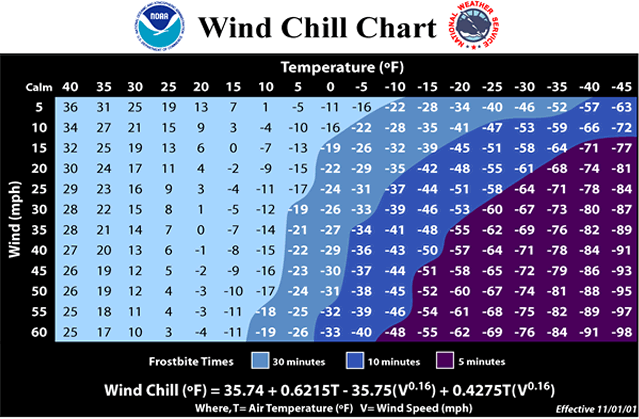The wind chill temperature is how cold people and animals feel when outside. Wind chill is based on the rate of heat loss from exposed skin caused by wind and cold. As the wind increases, it draws heat from the body, driving down skin temperature and eventually the internal body temperature. Therefore, the wind makes it FEEL much colder. If the temperature is 0°F and the wind is blowing at 15 mph, the wind chill is -19°F. At this wind chill temperature, exposed skin can freeze in 30 minutes.
The only effect wind chill has on inanimate objects, such as car radiators and water pipes, is to shorten the amount of time for the object to cool. The inanimate object will not cool below the actual air temperature. For example, if the temperature outside is -5°F and the wind chill temperature is -31°F, then your car's radiator will not drop lower than -5°F.
Frostbite occurs when your body tissue freezes. The most susceptible parts of the body are fingers, toes, ear lobes, and the tip of the nose. Symptoms include a loss of feeling in the extremity and a white or pale appearance. Get medical attention immediately for frostbite. The area should be SLOWLY rewarmed using warm, not hot, water.
- Hypothermia occurs when body temperature falls below 95°F. Determine your temperature with a thermometer.
- Warning signs include uncontrollable shivering, memory loss, disorientation, incoherence, slurred speech, drowsiness and exhaustion.
- Get medical attention immediately. If you can't get help quickly, begin warming the body SLOWLY. Warm the body core first, NOT the extremities. Warming extremities first drives the cold blood to the heart and can cause the body temperature to drop further--which may lead to heart failure.
- If you are helping someone else with hypothermia, get the person into dry clothing and wrap them in a warm blanket. Be sure to cover the head and neck.
- Do not give the person alcohol, drugs, coffee, or any HOT beverage or food. WARM broth and food is better.
- About 20% of cold related deaths occur in the home. Young children under the age of two and the elderly (those over the age of 65) are most susceptible to hypothermia.
- Hypothermia can set in over a period of time. Keep the thermostat above 69°F, wear warm clothing, eat food for warmth, and drink plenty of water or fluids other than alcohol and caffeine to keep hydrated.
- Avoid alcohol because it will LOWER your body temperature.
The best way to avoid hypothermia and frostbite is to stay warm and dry indoors and outdoors. When you must go outside, wear several layers of loose-fitting, lightweight, warm clothing. Trapped air between the layers will insulate you. Remove layers to avoid sweating and chill. Outer garments should be tightly woven, water repellent and hooded. Wear a hat because much of your body heat can be lost from your head. Cover your mouth to protect your lungs from extreme cold. Mittens, snug at the wrist, are better than gloves. Try to stay dry and out of the wind.
The air temperature has to be BELOW freezing for frostbite to develop on exposed skin. Wind chill can NOT bring the temperature to below freezing for humans and animals when the thermometer says it is above freezing so you will not get frostbite; however, you might get hypothermia from exposure to cold. In summary, you can only get frostbite if the actual air temperature, not the wind chill temperature, near your skin is below freezing.
The wind chill temperature is calculated using the following formula:
Wind chill (ºF) = 35.74 + 0.6215T - 35.75(V^0.16) + 0.4275T(V^0.16)
Where: T = Air Temperature (F)
V = Wind Speed (mph)
^ = raised to a power (exponential)
Wind chill Temperature is only defined for temperatures at or below 50°F and wind speeds above 3 mph. Bright sunshine may increase the wind chill temperature by 10°F to 18°F.
Criteria for issuing official NWS wind chill warnings and advisories are set locally. For the Rochester, NY, area, wind chill warnings are issued when the wind chill temperature is expected to fall at or below -25°F. Wind chill advisories are issued when the wind chill temperature is expected to fall between -15°F and -24°F.
Yes, wind chill applies only to people and animals. The only effect wind chill has on inanimate objects, such as car radiators and water pipes, is to more quickly cool the object to the current air temperature. The object will NOT cool below the actual air temperature. For example, if the temperature outside is -5°F and the wind chill temperature is -31°F, then your car's radiator will not drop lower than -5°F.
When NWS tested the new Wind Chill Temperature Index (WCTI), NWS researchers applied the new index to 12 test subjects. The results of the tests showed that relative humidity was an insignificant weather parameter, affecting the outcome to less than 1 degree. To simplify the calculation, relative humidity was left out of the formula.
The tests that were done on wind chill were conducted on adult subjects. For legal and safety reasons, NWS did not ask for child volunteers. Use the existing chart as a starting point and be even more cautious with children, seniors and persons with compromised health.
Information on cold-related health problems and winter storm safety from the Centers for Disease Control and Prevention (CDC)
